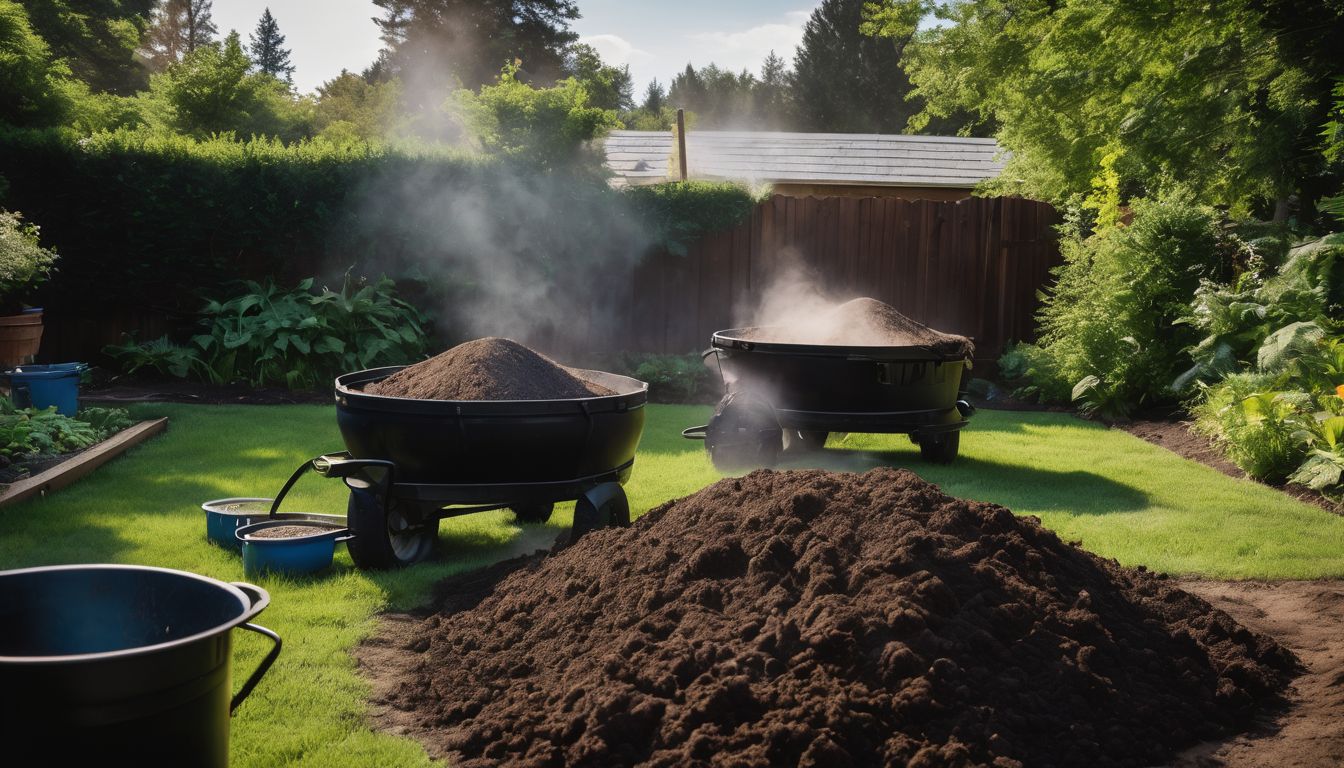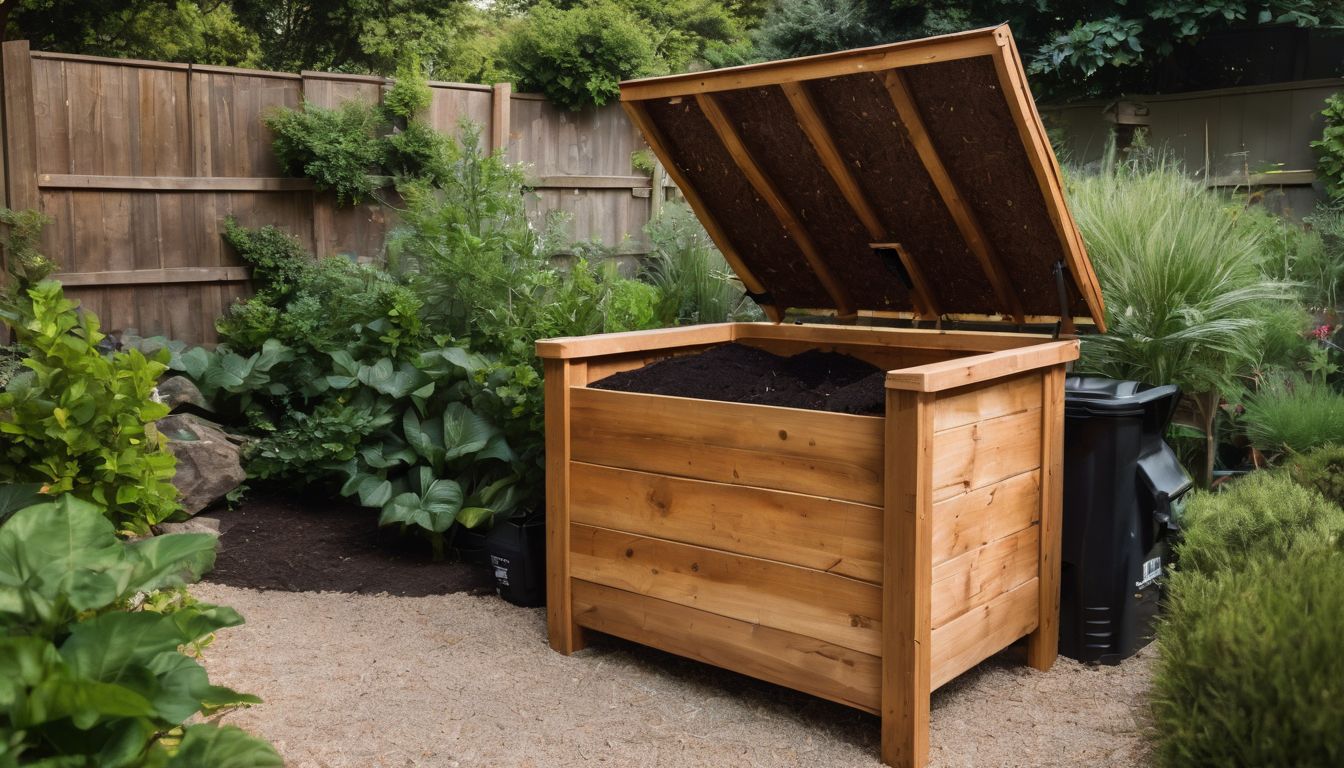Do you feel worried about the heaps of food waste ending up in landfills? Every year, tonnes of organic material go to waste when they can replenish our earth. Our guide introduces an eco-friendly superhero: community composting; it’s simple, social, and sustainable.
Dive into making dirt that gives back!
Key Takeaways
- Community composting transforms local organic waste into valuable fertiliser, reducing landfill waste and greenhouse gas emissions.
- Starting a community compost involves taking training courses, choosing the right location and partners, developing a balanced compost recipe, and regularly managing the compost pile for efficiency.
- A variety of models exist for community composting initiatives including collection services, drop-off sites, co-ops/partnerships with businesses or schools, each offering different opportunities for involvement.
- Funding can be sourced through grant programs and community outreach efforts are key to educate about the importance of organic waste recycling.
- Advocating for community composting by starting your own program or supporting existing ones leads to sustainable environmental practices in your local area.
What is Community Composting?
Community composting is the process of recycling organic waste within a local community, typically through the collection and processing of food scraps, yard trimmings, and other biodegradable materials.
The goal is to divert organic material from landfills and turn it into nutrient-rich compost for use in gardens and urban agriculture.
Definition and principles
Community composting turns local organic waste into valuable fertiliser for the community. This process involves collecting food scraps and garden waste from homes, schools, and businesses to create compost.
The core principles include reducing waste sent to landfills, lowering greenhouse gas emissions, and creating a nutrient-rich resource for growing food locally.
Proper management of a compost site is essential to make sure it works well. This means balancing carbon-rich materials like leaves with nitrogen-rich food scraps, ensuring enough moisture and air get in to help break down the material efficiently.
By following these steps, everyone contributes to sustainability while fostering environmentalism within their community. Next up: exploring the benefits this green practice brings to our communities.
Benefits of community composting
Community composting offers a range of benefits, including reducing the environmental impact of organic waste. By diverting food scraps and yard waste from landfills, communities can significantly decrease methane emissions that contribute to climate change.
Moreover, community composting fosters local economic development by creating opportunities for small businesses and entrepreneurs in organic material sourcing and compost site management.
Participating in community composting promotes social wellbeing by engaging individuals in meaningful environmental activism. It also encourages community engagement through educational outreach programs that raise awareness about waste reduction and green living practices.
This inclusive approach empowers people to take an active role in building food scrap composting infrastructure and supporting environmentally friendly initiatives.
Getting Started with Community Composting
Start by taking a composting training course to learn the basics. Then, choose a location and partners for your project, develop a compost recipe, and create a compost pile.
Take a training course
To get started with community composting, consider taking a comprehensive training course. Here’s what you need to know:
- Find accredited courses from local environmental organisations or the US Composting Council resources.
- Learn about the science of composting and best practices for organic waste recycling.
- Understand the social and economic wellbeing impacts of community composting.
- Gain knowledge on creating and managing small local businesses related to composting initiatives.
Choose a location and partners
- Look for a site that is easily accessible to participants and has enough space to accommodate the composting activities.
- Partner with local businesses, schools, or community organisations that are willing to collaborate on the project, share resources, or provide a suitable location for composting.
- Consider collaborating with nearby farms or gardening groups to facilitate the use of the compost and distribute it back into the community.
- Assess potential partnerships based on shared values and commitment to environmental conservation.
- Ensure that the chosen location aligns with local regulations and zoning requirements for composting activities.
Develop a compost recipe
After choosing a location and partners for your community composting project, the next step is to develop a compost recipe. Here are the key steps to create an effective compost recipe:
- Begin by gathering a mix of “green” materials such as fruit and vegetable scraps, and “brown” materials like dried leaves and cardboard.
- Maintain a good balance between nitrogen-rich green materials and carbon-rich brown materials to ensure proper decomposition.
- Chop or shred larger pieces of waste to speed up the composting process and provide a more uniform mixture.
- Layer the green and brown materials in your compost pile, ensuring that air can circulate through it easily.
- Turn or aerate the pile regularly to encourage microbial activity and speed up decomposition.
- Monitor the moisture level – the ideal moisture content is that of a wrung-out sponge – not too wet or too dry.
- Adjust the recipe as needed based on the rate of decomposition and odor control.
Create a compost pile
After developing a compost recipe, the next step is to create a compost heap. This process involves layering organic materials to start the decomposition process. Here’s how to do it:
- Select a suitable location for your compost heap, ensuring easy access and good drainage.
- Layer brown materials like dry leaves, straw, or shredded paper, followed by green materials such as food scraps and grass clippings.
- Add water to keep the heap moist but not waterlogged.
- Turn the heap regularly to aerate and mix the contents.
- Monitor the temperature and moisture levels to ensure proper decomposition.
- As the materials break down, the compost heap will shrink in size and transform into nutrient – rich soil amendment for your garden.
Models of Community Composting
Collection services, drop-off sites, co-ops or partnerships, and school or community gardens are some of the different models of community composting initiatives you can get involved in.
To find out more about how you can participate in these programs and make a positive impact on the environment, keep reading!
Collection service
Community composting collection services offer a convenient way for environmentally conscious individuals to participate in composting initiatives. Residents can simply separate their food scraps and other compostable materials, and the collection service will pick them up regularly.
This model not only diverts organic waste from landfills but also encourages more people to get involved in environmental wellbeing efforts within their community.
Participating in a collection service is an easy and effective way for individuals to contribute to the conservation of resources and reduction of greenhouse gas emissions. It provides an accessible solution for those who may not have the means or space to compost at home, making it a practical choice for many people looking to support local environmental initiatives without significant time or effort investment.
Drop-off sites
Community composting drop-off sites are convenient locations where individuals can bring their food scraps and other organic materials for composting. These sites are often situated in easily accessible areas such as community centers, farmers’ markets, or local businesses.
Once the materials are dropped off, they are then managed and processed by the community composting program, turning waste into valuable compost for use in gardens and local green spaces.
Engaging with drop-off sites is a simple yet impactful way to participate in community composting initiatives. By separating organic waste from regular trash and bringing it to these designated locations instead of throwing it away, individuals can directly contribute to environmental conservation efforts while nurturing a sustainable cycle of resource reuse within their communities.
Co-op or partnership
Partnering with local businesses or organisations can amplify the impact of community composting. By forming a co-op or partnership, you can pool resources, share responsibilities, and expand the reach of your composting efforts.
Collaborating with local restaurants or grocery stores to collect food scraps for composting is a great way to divert organic waste from landfills while fostering strong community ties.
Additionally, partnering with schools or community centres can provide valuable educational opportunities about sustainability and waste reduction.
Pooling resources and knowledge through a co-op or partnership enables more efficient management of community compost sites. It also encourages broader participation in composting initiatives by engaging diverse groups within the community.
School or community garden
After successfully establishing a co-op or partnership for community composting, consider the potential of creating a school or community garden. This initiative allows for an integrated approach to waste reduction and environmental education.
School gardens provide opportunities for hands-on learning about composting, soil health, and sustainable food production. Community gardens serve as valuable spaces for local residents to come together, grow their own produce, and contribute organic waste to communal composting efforts.
Engaging with schools and community groups to develop garden spaces can strengthen the ties within the neighborhood while promoting environmental stewardship. These sites also offer practical locations for managing on-site organic waste through composting programs, further supporting sustainability in the community.
Fundraising for Community Composting
Look into grant programs and community outreach and education to raise funds for your community composting initiative. There are various sources of funding available to support your project, so make sure to explore all options.
Grant programs
- Research local and national grant programmes that specifically support community composting projects. Look for grants that align with your project’s goals and mission.
- Prepare a comprehensive proposal outlining the objectives, budget, and impact of your community composting initiative to increase your chances of securing funding.
- Collaborate with other organisations or partners in your community to apply for larger grant opportunities that require collective efforts.
- Leverage crowdfunding platforms to engage the community in supporting your composting project financially.
- Engage local businesses and sponsors who are committed to environmental conservation as potential sources of grants or donations.
Community outreach and education
To expand your community composting initiative, engaging in outreach and education programmes is crucial. By raising awareness about the benefits of composting and its positive impact on the environment, you can inspire others to participate.
Hosting workshops, distributing educational materials, and giving presentations are effective ways to educate the community about composting practices. Engaging with local schools, community centres, and events will also help spread the message further.
Encouraging active participation in composting activities through community engagement events such as clean-up drives or garden projects can foster a sense of ownership and responsibility among participants.
Conclusion and How to Get Involved
Get connected with local community composting initiatives and see how you can support their efforts. Consider starting your own programme or partnering with existing organisations to advocate for community composting in your area.
Take action to make a positive impact on the environment through community composting initiatives.
Connect with local community composting initiatives
Support the mission of local community composting projects by getting involved
Start your own program
To start your own community composting programme, follow these steps:
- Identify a suitable location for the compost site, such as a community garden or local green space.
- Research local regulations and obtain any necessary permits or permissions for the composting operation.
- Engage with potential partners, such as local businesses, schools, or environmental organisations, to garner support and involvement.
- Educate the community about the benefits of composting and recruit volunteers to help with various aspects of the programme.
- Develop a clear plan for collecting and managing organic waste, including setting up collection bins and organising transportation logistics.
- Create a compost recipe tailored to the types of organic materials available in your area while considering factors such as moisture and aeration levels.
- Monitor and manage the compost pile regularly to ensure proper decomposition and maintenance.
Support and advocate for community composting.
Once you have started your own programme, it is important to support and advocate for community composting. Here are some ways you can get involved:
- Promote the benefits of community composting through educational workshops and seminars in your local area. Spread awareness about the environmental impact of waste and the benefits of composting.
- Collaborate with local businesses, schools, and community leaders to advocate for policies that support and expand community composting initiatives. Get involved in local government meetings to voice your support.
- Volunteer at existing community compost sites to help with maintenance, organising workshops, or outreach events. Your physical efforts can make a real difference.
- Connect with other like – minded individuals through social media or local environmental groups to form a strong network of supporters for community composting.
- Partner with local organisations to host fundraising events or campaigns that will generate financial support for new or existing community composting projects in your area.
FAQs
1. What are community composting initiatives?
Community composting initiatives are programs within neighborhoods where people come together to compost their food scraps, reducing waste and improving soil for gardening.
2. How can I participate in a community composting program?
You can get involved by finding a local community compost site or volunteering at existing programs near you, helping with running the site and processing the scraps into compost.
3. Is starting a new community composting project difficult?
Starting your own community composter could be manageable! It involves gathering others who share an interest in environmental stewardship and setting up a system to collect and break down organic waste within your area.
4. Are there different types of programs for participating in community composting?
Yes, there are various types of programs available depending on each community’s needs – from small collection bins at homes to larger communal sites that handle greater volumes of material.





